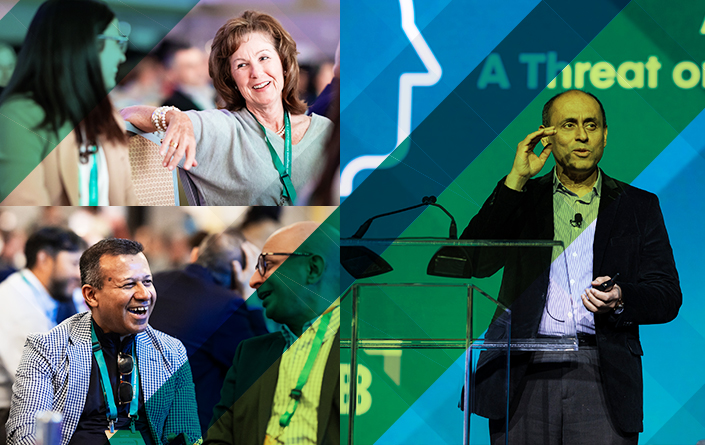Experiential—And Online
- At Temple University’s Fox School of Business, professors carefully craft group projects to make sure they’re suitable for online students in different time zones.
- The school offers students international exposure through online modules that cover political, business, and cultural aspects of other countries.
- The Fox School replicates in-person case study discussions through Zoom sessions and virtual reality platforms.
It’s estimated that while people might remember 10 percent of what they read, they’ll remember 90 percent of what they do. If that's the case, then experiential learning is a powerful tool for bridging the gap between theory and practice.
But how can business schools provide hands-on learning in an educational environment that is increasingly virtual? A recent webinar from AACSB’s Online Learning Affinity Group explored that very question. The three speakers, all from Temple University’s Fox School of Business in Philadelphia, described how they have converted in-person interactions into online activities. By doing so, they are providing students with a wider range of experiences while preparing them to handle real-world situations.
Translating the Group Project
The Fox School organizes experiential learning activities into three progressively more complex levels: theoretical learning (guest speakers and simulations), observational activities (case studies, field trips, and job shadowing), and hands-on learning (live projects, internships, and cooperative programming). The school layers each activity in a cyclical way: Students first have a concrete experience, then they reflect on it and distill lessons from it, and finally they use those lessons in their next learning experience.
To encourage faculty to incorporate experiential learning activities into their classrooms, the school offers a Canvas training course, suggests additional reading materials, and runs an experiential learning awards program. Professors apply for the awards by describing their assignments, their assessment strategies, and the student feedback they’ve received. Previous awardees often serve on the judging committee and act as guest speakers at events.
As important as hands-on learning experiences are, they’re sometimes challenging to translate into virtual environments, notes Misty Blessley, an associate professor in the department of statistics, operations, and data science. She meets the challenge by designing carefully crafted group projects, including those for the capstone course of her procurement class. For these projects, groups of students must learn about and virtually gather all the components needed to make specific products.
For instance, one recent group was tasked with making two different kinds of India pale ale, a chocolate version and a vanilla version. Students found out that they would need seven or eight gallons of water to make a gallon of beer—but all water is not the same. As they learned when subject matter experts joined the class, water obtained from different sources might have different mineral makeups and varying levels of chlorine.
In addition to learning about the ingredients, students had to figure out how to package the bottles and transport them across state lines. Blessley ran a site called Focused Buyer, in which she acted as a supplier of products such as corrugated cardboard. Students would ask her for quotes for essential materials, and they would have to determine which ones best suited their purposes and why.
In an educational environment that is increasingly virtual, schools can convert in-person activities into online activities that prepare students to handle real-world situations.
She knows these group projects will be successful only if it’s easy for students to interact. Therefore, she makes sure to create groups that meet at different times of day to accommodate students in different time zones.
“I tell students, ‘If you know who you want to work with, tell me. If you don’t know, tell me when you want to work, and I can put a group together,’” Blessley says. “If we can’t put students in a situation where it’s easy to work together, they’ll spend all their time and energy trying to find a time to work together or just not wanting to engage with one another.” The more quickly students can connect with each other, the more time they have to concentrate on their projects—and to learn the relevant lessons.
Rethinking International Travel
The group project is one key component of experiential learning—international exposure is another. Many schools offer semesterlong or yearlong study abroad programs, but these can be out of reach for students with financial challenges or personal and professional commitments.
For that reason, Fox runs Global Immersions that are linked to a three-credit business elective. During these immersions, which last seven to 10 days each, students head out to targeted destinations to meet with business executives, tour facilities, enjoy cultural experiences, and connect with Fox alums. However, even these experiences became unmanageable in 2020 when COVID protocols severely limited global travel.
The Fox School responded by creating Fox Without Borders, a virtual experience that offers glimpses into other cultures. Each session of the four-week noncredit module is delivered online one night per week from 8 p.m. to 9:30 p.m. Eastern time.
“I did not want canned recordings, so everything is live and as authentic as possible,” explains Phyllis Tutora, the senior director of international and executive programs. “We opened the series up to alums as well, and it’s been a fantastic way for students and alumni to mingle.”
In the first session, the instructor takes an academic approach to covering the region students will visit. In the second session, students hear from professionals who live or work in the country and who can discuss business, cultural, and social experiences. For instance, during a module centered on China, the school contracted with a Beijing tour guide who took the class on a virtual tour of the Forbidden City. In the third session, students have a dialogue with an expert about the country’s business, social, cultural, and political landscape.
When international travel is impractical, students can participate in Fox Without Borders, a four-week noncredit experience that offers glimpses into other cultures.
The fourth session features a fun cultural activity. For a 50 USD fee, students receive a box full of items they will need to participate. For example, during a module focused on Colombia, students received a box of coffee samples so they could do at-home tastings after hearing an overview of the industry from a coffee expert.
During a module about Argentina, students learned about marketing strategy development, product positioning, and sustainable practices. Then they enjoyed cultural activities such as watching tango dancing and taking a virtual tour of Buenos Aires. The cultural activity for an Egyptian module was belly dancing, with students learning the moves from an online instructor.
Other Fox Without Borders destinations have included Indonesia, Kenya, Israel, and Chile. Through virtual travel, Tutora points out, “we can go anywhere we want. We don’t have to worry about in-country safety, infrastructure, or political instability.”
Students who complete the modules earn Global Business Professional Certifications. The programs have been so popular at both the graduate and undergraduate levels that the school has continued to offer them in the spring and fall even though it has resumed in-person Global Immersions. At times, the school will offer the online program one semester, then follow it up the next year with a Global Immersion to the same country to provide a more in-depth experience.
Making the Discussion Virtual
Like group projects and international experiences, case study discussions are common in-person classroom activities that can be difficult to incorporate into online education. The Fox School had taken steps to address that problem even before the arrival of COVID. In March 2020, the school debuted a virtual reality classroom for a five-week course called Fintech, Blockchain, and Digital Disruption. The program, which was created with the aid of an outside vendor, continues today.
The course includes interactions that occur both over Zoom and through virtual reality sessions facilitated by Oculus headsets that make students feel as if they’re all together in a classroom. To ensure that students are comfortable using the headsets, the school ships them out in advance and offers training with instructional technologists.
“Virtual reality is different from Zoom, which consists of one-on-one conversation or one person talking and everyone else listening,” says Bora Ozkan, associate professor of finance. “This is a more engaging environment.” For instance, because the headsets have directional sensors, if someone in the back of the simulated room talks, students (and their avatars) can swivel their heads to look in that direction.
Over the years, the school has worked with the platform to upgrade the simulated classroom from a relatively flat look to an auditorium style that mimics a U-shaped two-tiered space. The classroom also offers features such as a whiteboard where the instructor can “write” key talking points from the discussion.
While case study discussions can be difficult to replicate online, virtual reality technology allows students to interact as if they’re all together in a classroom.
Students can interact well enough to do team-building exercises such as pass the ball. As the tech has improved, students are able to see details such as the smartwatches on their classmates’ wrists. They feel as if they are sitting side-by-side with peers and sometimes even try to high-five each other.
Even so, the tech still has some limitations:
- While students can see the case on the screen in front of them, they can’t take notes within the environment. However, they can go back and look at recordings.
- There are three- and four-second delays in the livestream, which can be disconcerting.
- The classroom only holds 30 students.
- Avatars have limited options and no facial expressions.
- The headsets are heavy, so students become fatigued after about 40 minutes.
Despite the drawbacks, the technology is providing students with rich interactive experiences even in online formats.
Wide-Ranging, Rewarding—and Virtual
Now that the school is gaining momentum in offering virtual experiential learning, its faculty have started taking advantage of these online capabilities in other areas—including international consulting projects. MBA students now can provide live consulting services to clients anywhere in the world. To date, more than 600 projects have been completed, and clients have reported that they have made or received 394 million USD as a result of students’ work.
“The challenge is to make sure that we’re offering students similar experiences across the board and achieving the same learning objectives,” says Ozkan. “Even if students are working on different projects for different companies, we want the course to wrap around everything they’re learning in the MBA program.”
From simulated classrooms to wide-ranging consulting possibilities, online education remains the best option for many students. That’s why it’s critical that faculty find ways to make these virtual experiences as rich and rewarding as possible.
When business schools can incorporate experiential learning into digital educational formats, they can expand what they have to offer students in nearly unlimited ways. With such global exposure, their graduates will be better prepared to enter the workforce and make contributions from day one.





